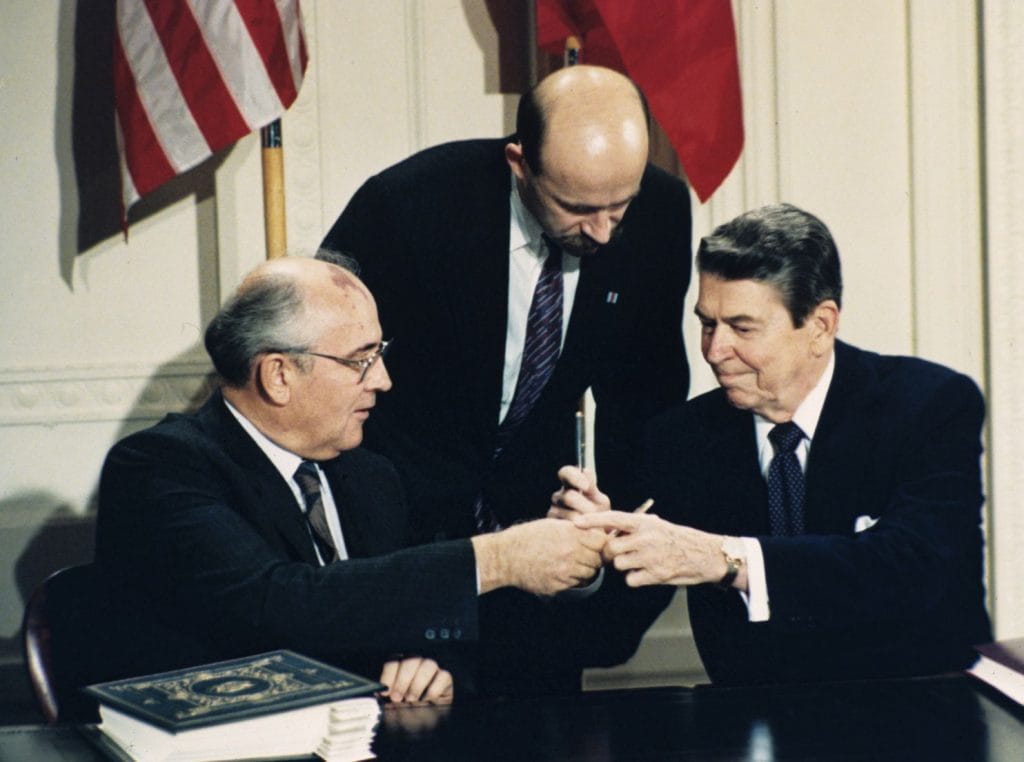
If you want peace, prepare for war
President Ronald Reagan, right, with Soviet leader Mikhail Gorbachev in Washington in 1987. (Bob Daugherty/AP)
Scholars have already debated for decades, and will debate for centuries, the role U.S. policies — military, diplomatic, economic — played in bringing the Cold War to endgame and the Soviet Union to extinction. One milestone was Ronald Reagan’s 1983 Strategic Defense Initiative proposal, a technological challenge that could not be met by a Soviet economy already buckling under the combined weight of military spending and socialism’s ignorance. But before SDI, there was Ocean Venture ’81, approved by Reagan as president-elect.
The protracted strategy, of which this enormous operation — 15 nations’ navies, 250 ships, more than 1,000 aircraft — was a harbinger, came to be referred to by some Soviets as the “Lehman strategy.” In “Oceans Ventured: Winning the Cold War at Sea,” John Lehman, a Navy aviator who was secretary of the Navy during Reagan’s first six years, explains the Navy’s role in the “forward strategy” that implemented Reagan’s Cold War policy. Reagan explained the policy when asked about it in 1977: “We win and they lose, what do you think of that?”
Among Reagan’s early actions — in addition to reinstating the MX missile and B-1 bomber programs that President Jimmy Carter had suspended — was to increase by 11 percent Carter’s fiscal 1981 Navy budget, and increase by 15 percent the fiscal 1982 request. By 1980, there was rough nuclear parity, and the Soviets, with 280 divisions, had superiority of land forces. Reagan campaigned on building the U.S. Navy to 600 ships and using it for purposes beyond merely keeping sea lanes open to deliver supplies for land forces.
Those purposes included signaling U.S. confidence and ambition — what Lehman calls a “combat-credible forward naval presence” — to ratchet up psychological pressure on Soviet leaders. So, in the autumn of Reagan’s first year, Ocean Venture ’81 surged U.S. naval power into what the Soviet Union had considered its maritime domain, especially the Norwegian and Barents seas. (And eventually under the Arctic ice pack, where the Soviets had hoped to hide nuclear ballistic-missile missile submarines.) By dispersing Ocean Venture ’81 ships when Soviet satellites were overhead, the arrival of a large flotilla in northern waters was an unnerving surprise for Moscow.
This “transformative” operation, Lehman writes, “came as a thunderclap to the Soviets, who had never seen such a NATO exercise on their northern doorstep.” “In preceding years,” he says, “during the hopeful pursuit of detente and arms control by Presidents Ford and Carter, such robust NATO activity would have been unthinkable, as provocative to the Soviets.” Provocation was a risk worth running, but a real risk:
“The Soviets were particularly fearful of being attacked under cover of a forward U.S. exercise. Why? Because their own doctrine was to use military exercises to mask surprise invasions,” as they did with Poland in 1981. Soviet doctrine’s “central concept was a high-speed offensive launched [against NATO] under the cover of military exercises in East Germany and Czechoslovakia.”
Lehman says that in 1986, with Mikhail Gorbachev inching crabwise toward acknowledging the Soviet Union’s terminal sclerosis, “the most delicate period of the Reagan naval strategy began.” Reagan would continue to deploy and demonstrate the multiplying U.S. military proficiencies, but would avoid a triumphalism that might provoke an anti-Gorbachev coup by the humiliated Soviet military.
By the end of 1986, with the Soviets having learned they could not interfere with U.S. aircraft carriers operating in Norwegian fjords, the Soviet general staff told Gorbachev they could not defend the nation’s northern sector without tripling spending on naval and air forces there. Thus did the Cold War end because Reagan rejected the stale orthodoxy that the East-West military balance was solely about conventional land forces in central Europe, so NATO’s sea-power advantage was of secondary importance.
Today’s naval problems posed by a rising China, particularly in the South China Sea, are unlike the problem of hastening the Soviet decline. Today’s U.S. ships are more capable than ever, but too few for comfort, as Lehman’s reader will realize when they consider what only the Navy can do.
In the 1992 film “A Few Good Men,” a furious Col. Nathan R. Jessep (Jack Nicholson) exclaimed to his courtroom tormentors — Navy officers — words that are actually true regarding almost all civilians in this age of complex professional military establishments configured for myriad and rapidly evolving threats: “You have no idea how to defend a nation.” Lehman’s book is a rare window into that world, and a validation of the axiom that if you want peace, prepare for war.
Read more from George F. Will’s archive or follow him on Facebook.


